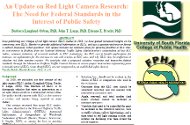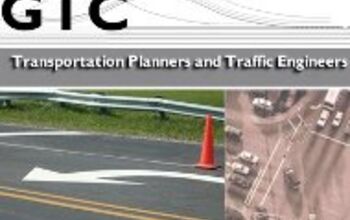Report Critiques Red Light Camera Research Methods
A peer-reviewed article published Wednesday in the Florida Public Health Review elaborated on a previous analysis of methods used in certain red light camera studies. University of South Florida (USF) researchers Barbara Langland-Orban, Etienne E. Pracht and John T. Large returned to clarify certain points raised in response to their 2008 report that concluded red light cameras tended to increase injury accidents ( view study).
“In our original critique, we faulted the research methods used in the Federal Highway Administration’s (FHWA) analysis titled Safety Evaluation of Red-Light Cameras,” the USF report stated. “One FHWA official subsequently contacted us to point out that we overlooked an important finding: fatal crashes at red light camera sites had increased, yet were ignored in the related economic analysis.”
Earlier this month, the Insurance Institute for Highway Safety (IIHS) generated a significant amount of positive publicity for red light cameras by claiming red light cameras caused a reduction in fatal accidents ( view report). The more rigorous FHWA study found that 0.5 percent of angle crashes were fatal in the “before” period without red light cameras. After cameras were installed, the figure grew to 0.8 percent. The FHWA study concluded there was a financial benefit from crash reductions due to the use of cameras, but only because the FHWA chose to exclude fatal accidents from their estimates. USF re-calculated the FHWA numbers including fatalities to find that red light camera use resulted in a net loss of $17,360 per intersection in estimated accident costs, according to the FHWA methodology.
The USF researchers took issue with the design of the FHWA study, but the greatest criticism was reserved for the “unscientific” studies performed by the IIHS and the Cochrane Collaboration. Both of these works drew sweeping conclusions from a simple before and after comparison that did not control for variables such as traffic volume, long-term accident trends and intersection geometry that could affect the results.
“The studies that integrated relevant independent variables in the analysis found red light cameras were associated with increases in crashes and injuries,” the report stated ( view rigorous studies). “This reveals the complexity of conducting public health research because an outcome can be incorrectly attributed to an intervention if variables necessary to explain the outcome are excluded.”
The USF researchers explained that red light cameras may increase injury accidents because most red light running accidents are the result of unintentional mistakes. For example, a driver is distracted and did not notice that the light was red, causing a collision. The presence of a camera would not have altered the outcome because if the signal itself was missed, it is not likely the camera would be noticed.
“Understanding root causes of red light running crashes (e.g., intentional versus unintentional infractions, driving under the influence, or traffic signal or intersection defects) is necessary to advance remedies that are specific to the problem,” the report stated. “In contrast, red light camera advocates presume red light running crashes occur from willful red light running.”
The report concluded that federal standards should be established to require engineering analysis before the installation of red light cameras. It also recommends full transparency in the reporting of accident data at red light camera locations.
A copy of the analysis is available in a 90k PDF file at the source link below.
Update on Red Light Camera Research (Florida Public Health Review, 2/23/2011)
[Courtesy: Thenewspaper.com]
More by The Newspaper
Latest Car Reviews
Read moreLatest Product Reviews
Read moreRecent Comments
- Zerofoo No.My wife has worked from home for a decade and I have worked from home post-covid. My commute is a drive back and forth to the airport a few times a year. My every-day predictable commute has gone away and so has my need for a charge at home commuter car.During my most recent trip I rented a PHEV. Avis didn't bother to charge it, and my newly renovated hotel does not have chargers on the property. I'm not sure why rental fleet buyers buy plug-in vehicles.Charging infrastructure is a chicken and egg problem that will not be solved any time soon.
- Analoggrotto Yeah black eyeliner was cool, when Davey Havok was still wearing it.
- Dave M. My sweet spot is $40k (loaded) with 450 mile range.
- Master Baiter Mass adoption of EVs will require:[list=1][*]400 miles of legitimate range at 80 MPH at 100°F with the AC on, or at -10°F with the cabin heated to 72°F. [/*][*]Wide availability of 500+ kW fast chargers that are working and available even on busy holidays, along interstates where people drive on road trips. [/*][*]Wide availability of level 2 chargers at apartments and on-street in urban settings where people park on the street. [/*][*]Comparable purchase price to ICE vehicle. [/*][/list=1]
- Master Baiter Another bro-dozer soon to be terrorizing suburban streets near you...


































Comments
Join the conversation
The red light cameras are a scam. Originally, traffic laws had safety as their goal. Thus, there were certain minimum yellow light durations - the higher the speed limit, the longer they would be. Cities, insofar as they use these devices, are putting revenues over safety. Red light violations and accidents decline as yellow light durations increase. When a California city increased yellow light duration from 3 seconds to 4, violations declined from 10 to 1.3 per day. These cameras require a dangerously short yellow to make any money - without it, they are unprofitable, and removed shortly thereafter. There is a wealth of information about the flaws of red light cameras and traffic laws in general, how safety and efficiency are decidedly not the guiding principles behind traffic regulations. Source: http://www.thenewspaper.com/news/31/3110.asp
NO! We need more red light cameras and less yellow times at all intersections so that the municipality that installs them can make up for all the wasteful non-budgetary spending that occurs and all of the ridiculous pay raises that government managers get at the expense of the people like the well won't run dry! WE NEED MORE RED LIGHT CAMERAS!!!!! INSTALL THEM NAOOOOO!!!!!! (escapes from straitjacket) MORE RED LIGHT CAMERAS!!!!!!!!!!!!! (close-up of watery drippy nostril)